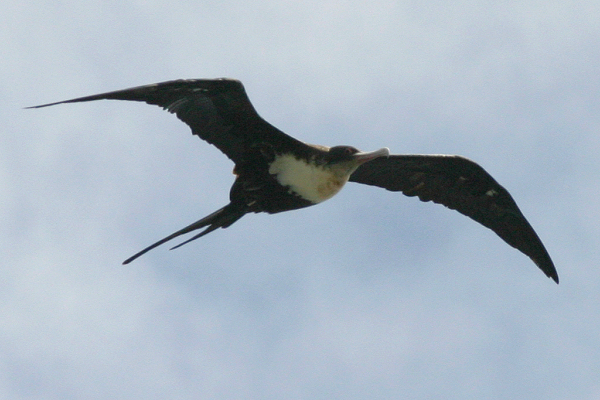
Location: Kaua'i, Hawaii
Date: 2005-07-16
Lens: Canon 300mm IS F4 + 1.4x II Converter

 Great Frigatebird
Fregata minor
Great Frigatebird
Fregata minor
 Description
Description
Great Frigatebirds do not land in water because they produce very little oil. So they use their long, hooked bills to grab prey from the ocean surface. Prey primarily consist of fish and squid. Frigatebirds often supplement their diet by pirating food from boobies, tropicbirds, and shearwaters. Great Frigatebirds tend to forage far out at sea.
Perhaps the most striking feature of frigatebirds is the male's red throat pouch, which the male inflates into a large red balloon during courtship displays. The males tend to display in groups. To attract a female, the male wiggles his head from side to side, shake his wings, and calls. If the display is attractive enough, the female will join him.
The males of the two frigatebird species, Great and Magnificent, are difficult to tell apart. Their call is one way to separate them. Great frigatebirds make a "gobbling" sound, similar to a turkey, while Magnificent Frigatebirds make a rattling or drumming sound.
General: Long, slender wings as seen in flight. On average, females are larger than males. 34 to 40 inches in length.
Adult Male: Entirely black plumage with greenish irridescence. Crimson-red, inflatable throat pouch. Long, hooked, dark bluish-gray bill. Deeply forked tail. Red to reddish-brown legs and feet.
Adult Female: Black head, neck, back, belly, wings, and tail. White breast. Long, hooked, dark bluish-gray bill. Reddish eye ring. Deeply forked tail. Pink to reddish-pink legs and feet.
Juveniles: Similar to adult, but has rusty to white head and throat.
Pelagic
 Nesting
Nesting1 egg. The egg has an average 55 day incubation period. Fledging occurs in 120-145 days. Both parents incubate the egg in shifts that last about 3 days. The nest is a stick platform built on top of shrubs. After fledging the young are dependent on the parents, usually the female, for up to 18 months. Females to not breed every year because it takes a year and a half to raise a single chick. It is believed, however, that the males leave to breed with another female after the chick has fledged. Nests in colonies.